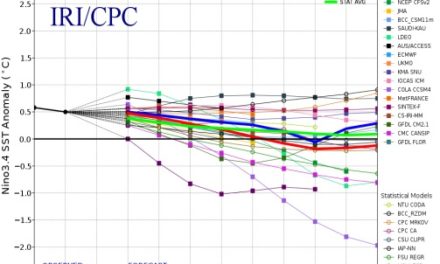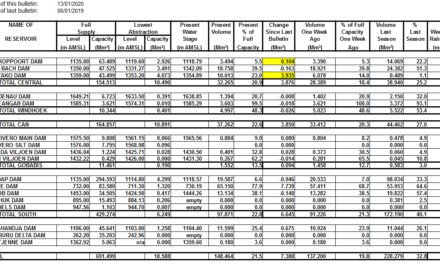
The Week’s Weather up to Friday 11 August. Five-day outlook to Wednesday 16 August 2017

Synoptic Map: Friday 11 August at 06:00. Barometric Pressure displayed as surface level isobars.
Source: South African Weather Service
The SA Weather Bureau’s standard early-morning synoptic map offers a good starting point to interpret what has happened during the week.
Note that the isobars are based on surface readings and does not make provision for differences in pressure that arise from elevation. Over land, the readings from actual weather stations will be slightly less than the values indicated on the map.
The first feature of note is the position and strength of the southern Indian high pressure cell located in the right half of the image. It has remained in this general position for more than a week, an indication of static conditions in the southern Indian Ocean between Africa and Australia. However, it has increased significantly in strength, its core growing from 1032 mB a week ago to a hefty 1040 mB on Friday morning. During the week, the core shifted south by a few hundred kilometres but the 1024 mB isobar remained more or less in the same place. 1024 mB is regarded as “normal” strength for the high pressure cells in the southern oceans. 1032 mB is typical for winter and 1040 mB indicates intensely cold, but also quiet conditions.
The second important feature is the position of the South Atlantic high in the bottom left corner. This high reads an even stronger 1044 mB but a cut-off low sits immediately north of it. While the South Atlantic high is also very strong, its core is situated much further south than the southern Indian high, at around 46° S latitude. This southward displacement indicates that its immediate effect on the African continent will be limited, with the cut-off low helping to reduce the impact of its northward extension. The presence of the cut-off low north of the high, indicates unstable, windy conditions.
The third feature is the extended frontal system, stretching more than 4000 km from the continent to the polar circle. Ahead of this front, airflow is from north to south while behind, the direction is from south to north.
The final feature to note is the presence of a high pressure cell over the eastern half of the sub-continent. This is almost like a bulge that extends backwards from the southern Indian high and it brings cold, stable conditions to the South African highveld.
As can be seen from the overall map, while there is a substantial trough from the southern tip of the continent, the front’s impact is restricted to the area south of the Orange River. Its impact on Namibia is limited.
Local weather is influenced more by the anti-cyclonic continental circulation which is the result of the high over South Africa.
These conditions show a typical late-winter stance. In Namibia it is experienced as see-saw weather meaning the nights are cold because of the overall high pressure control, but the zonal flow from east to west (on the northern rim of the high), coupled with the daily dose of solar energy, results in warm afternoons, and even hot conditions north and west of Etosha.
What’s Coming
Local conditions remain static throughout the weekend with only a slight cold disturbance which may reach the Karas Region. The front passes South Africa from west to east and by Sunday evening, conditions are static again.
By Monday the high has departed with lower pressures developing along the northern Namib coastline. This may lead to mild Oosweer on Monday afternoon from Walvis Bay to the Kunene River.
Another front approaches the Cape during Tuesday. It is well developed and will have an impact as far north as Grootfontein during Tuesday night. The system’s mobility, however, is very high and it migrates to the east very rapidly.
By Wednesday, the cold will be restricted to the south-western quadrant, i.e. along the Botswana border, through the Kalahari and into the Karasburg district, but only during the night. Frost is not expected, again, but the nights in these areas can go below 5°C.











































